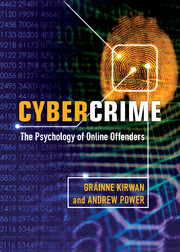Book contents
- Frontmatter
- Contents
- Detailed contents
- List of illustrations
- List of tables
- Preface
- 1 Psychology of cybercrime
- 2 Cybercrimes and cyberlaw
- 3 Hackers
- 4 Malware
- 5 Identity theft and fraud
- 6 Child predation and child pornography online
- 7 Cyberbullying and cyberstalking
- 8 Digital piracy and copyright infringement
- 9 Cyberterrorism
- 10 Crime in virtual worlds
- References
- Index
3 - Hackers
Published online by Cambridge University Press: 05 July 2013
- Frontmatter
- Contents
- Detailed contents
- List of illustrations
- List of tables
- Preface
- 1 Psychology of cybercrime
- 2 Cybercrimes and cyberlaw
- 3 Hackers
- 4 Malware
- 5 Identity theft and fraud
- 6 Child predation and child pornography online
- 7 Cyberbullying and cyberstalking
- 8 Digital piracy and copyright infringement
- 9 Cyberterrorism
- 10 Crime in virtual worlds
- References
- Index
Summary
Case studies
Former hacker Kevin Mitnick has made a career from advising on computer security and has authored a number of books on hacking, with a particular focus on social engineering methods (see, for example, Mitnick and Simon, 2002, 2005). He has admitted to breaking into the computer systems of several organisations, including the University of Southern California, Motorola, Fujitsu and Sun Microsystems. He used a variety of methods of infiltration, including social engineering, where he impersonated employees of some of the companies he victimised. He was sentenced to almost four years in prison, along with severely restricted access to computers for a further three years (US Department of Justice, 1999).
Adrian Lamo has also experienced a lot of publicity due to his hacking activities. His attempts to improve the security of firms led to mixed responses from the companies involved – some were highly appreciative of his efforts, while others filed lawsuits against him (see Mitnick and Simon, 2005). Probably his most famous hack involved infiltrating the New York Times private network and using their subscription to the search tool Lexis-Nexis, although he has had many other interesting hacking experiences (Kahn, 2004). More recently, Lamo has been in the news for turning in US military analyst Bradley Manning, after Manning reputedly ‘boasted’ to him about passing on confidential information to whistle-blowing website Wikileaks (BBC News Online, 7 June 2010).
- Type
- Chapter
- Information
- CybercrimeThe Psychology of Online Offenders, pp. 51 - 78Publisher: Cambridge University PressPrint publication year: 2013



